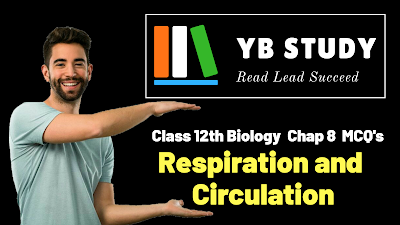Respiration and Circulation MCQ with Answers:
Important points:
- Respiration is a vital function of all living cells. It is function of the protoplasm and not confined to any particular organ or tissue.
- In this process food is broken down into simpler compounds such as carbon dioxide and water by an oxidative process and the energy stored in food is released in active form.
- This energy is used up by the plant in growth and other physiological processes which require an expenditure of energy.
- Besides transport of metabolites and gases, animals need to remove the waste products formed in their tissues, transportation of hormones to the target tissues and maintain homeostasis.
- All these functions are performed by the circulatory system.
- The system in which blood is circulated throughout the body is called circulatory system.
- Circulatroy system may be open or closed. Close circulatroy system as discovered by Wiliam Harvey (1628).

Respiration and Circulation is the scoring chapter in the board exam as well as medical entrance examination. Here we have collected some important MCQ on respiration and Circulation. These Respiration and Circulation MCQ Questions for all Concepts as per the latest syllabus of Maharashtra boards. Practice more on a regular basis with these NEET objective questions on Respiration and Circulation improve your subject knowledge & problem-solving skills along with time management. Respiration and Circulation Multiple Choice Questions make you feel confident in answering the question in the exam & increases your scores in the board exam.
Choose the correct alternatives from those given below and complete the statements.
1. The muscular structure that separates the thoracic and abdominal cavity is_______.
a. pleura
b. diaphragm
c. trachea
d. epithelium
Answer : Diaphragm
Explanation : The diaphragm separates the thoracic cavity, containing the heart and lungs, from the abdominal cavity and performs an important function in respiration: as the diaphragm contracts, the volume of the thoracic cavity increases, creating a negative pressure there, which draws air into the lungs.
2. What is the minimum number of plasma membrane that oxygen has to diffuse across to pass from air in the alveolus to haemoglobin inside a R.B.C.?
a. Two
b. Three
c. Four
d. Five
Answer : Five
3. ________ is a sound producing organ,
a. Larynx
b. Pharynx
c. Tonsils
d. Trachea
Answer : Larynx
Explanation : Sound producing organ of human being is the larynx. It is a cartilaginous box and is also known as the sound box. There are two vocal cords in the box which vibrate on the passage of air through them and hence produce sound.
4. The maximum volume of gas that is inhale during breathing in addition to T.V is_________
a. residual volume
b. I.R.V.
c. G.R.V.
d. vital capacity
Answer : I.R.V.
5. ________ muscles contract when the external intercostal muscles contract
a. Internal abdominal
b. Jaw
c. Muscles in bronchial walls
d. Diaphragm
Answer : diaphragm
6. Movement of cytoplasm in unicellular organisms is called __________.
a. diffusion
b. cyclosis
c. circulation.
d. thrombosis.
Answer : Cyclosis
Explanation : Cytoplasmic streaming, also called protoplasmic streaming and cyclosis, is where there is flow inside the cytoplasm. It is typically observed in large plant and animal cells. Here flow means that the cytoplasm is moving inside the cell, it is not stationary.
7. Which of the following animals do not have closed circulation?
a. Earthworm.
b. Rabbit
c. Butterfly
d. Shark
Answer : Butterfly
Explanation : All other orgnanism have closed circulatory system and Organisms with an open circulatory system typically have a relatively high volume of hemolymph and low blood pressure. Examples of animals with open circulatory systems include insects, spiders, prawns and most mollusks.
8. Diapedesis is performed by _________.
a. erythrocytes
b. thrombocytes
c. adipocytes
d. leucocytes
Answer : Leucocytes
9. Pacemaker of heart is _________.
a. SA node
b. AV node
c. His bundle
d. Purkinje fibers
Answer : SA Node
Explanation : The sinoatrial (SA) node or sinus node is the heart’s natural pacemaker. It’s a small mass of specialized cells in the top of the right atrium (upper chamber of the heart). It produces the electrical impulses that cause your heart to beat.
10. Which of the following is without nucleus?
a. Red blood corpuscle
b. Neutrophill
c. Basophill
d. Lymphocyte
Answer : Red blood carpuscle
11. Cockroach shows which kind of circulatory system?
a. Open
b. Closed
c. Lymphatic
d. Double
Answer : Open
Explanation : cockroach consist open circulatory system.
12. Diapedesis can be seen in _________ cell.
a. RBC
b. WBC
c. Platelet
d. neuron
Answer : WBC
13. Opening of inferior vena cava is guarded by __________.
a. bicuspid valve
b. tricuspid valve
c. Eustachian valve
d. Thebesian valve
Answer : Eustachian valve
Explanation : The inferior vena cava, larger than the superior, returns the blood from the lower half of the body, and opens into the lowest part of the atrium, near the atrial septum, its orifice (Opening of inferior vena cava) being directed upward and backward, and guarded by a rudimentary valve, the valve of the inferior vena cava (Eustachian valve).
14. ___________ wave in ECG represent atrial depolarization.
a. P
b. QRS complex
c. Q
d. T
Answer : P
15. The fluid seen in the intercellular spaces in Human is _________
a. blood
b. lymph
c. interstitial fluid
d. water
Answer : Interstitial fluid
Explanation : Interstitial fluid is found in the interstitial spaces, also known as the tissue spaces. Interstitial mixes with and becomes intercellular fluid when it flows between cells.
